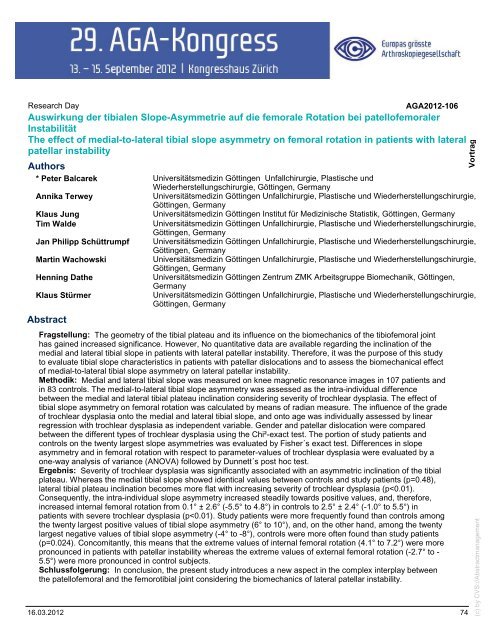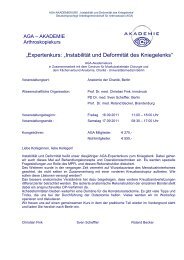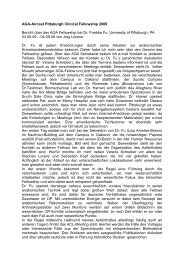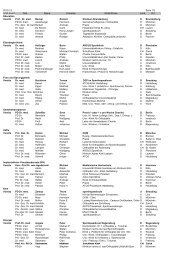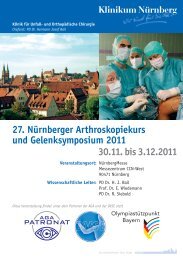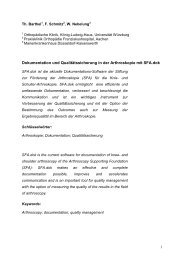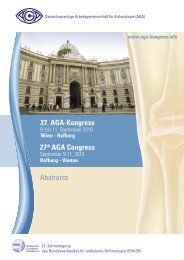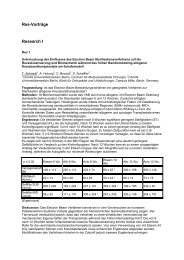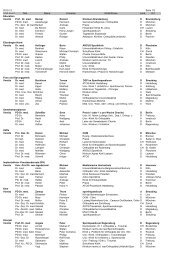als PDF - AGA
als PDF - AGA
als PDF - AGA
Erfolgreiche ePaper selbst erstellen
Machen Sie aus Ihren PDF Publikationen ein blätterbares Flipbook mit unserer einzigartigen Google optimierten e-Paper Software.
Research Day<br />
<strong>AGA</strong>2012-106<br />
Auswirkung der tibialen Slope-Asymmetrie auf die femorale Rotation bei patellofemoraler<br />
Instabilität<br />
The effect of medial-to-lateral tibial slope asymmetry on femoral rotation in patients with lateral<br />
patellar instability<br />
Authors<br />
* Peter Balcarek Universitätsmedizin Göttingen Unfallchirurgie, Plastische und<br />
Wiederherstellungschirurgie, Göttingen, Germany<br />
Annika Terwey Universitätsmedizin Göttingen Unfallchirurgie, Plastische und Wiederherstellungschirurgie,<br />
Göttingen, Germany<br />
Klaus Jung Universitätsmedizin Göttingen Institut für Medizinische Statistik, Göttingen, Germany<br />
Tim Walde Universitätsmedizin Göttingen Unfallchirurgie, Plastische und Wiederherstellungschirurgie,<br />
Göttingen, Germany<br />
Jan Philipp Schüttrumpf Universitätsmedizin Göttingen Unfallchirurgie, Plastische und Wiederherstellungschirurgie,<br />
Göttingen, Germany<br />
Martin Wachowski Universitätsmedizin Göttingen Unfallchirurgie, Plastische und Wiederherstellungschirurgie,<br />
Göttingen, Germany<br />
Henning Dathe Universitätsmedizin Göttingen Zentrum ZMK Arbeitsgruppe Biomechanik, Göttingen,<br />
Germany<br />
Klaus Stürmer Universitätsmedizin Göttingen Unfallchirurgie, Plastische und Wiederherstellungschirurgie,<br />
Göttingen, Germany<br />
Abstract<br />
Fragstellung: The geometry of the tibial plateau and its influence on the biomechanics of the tibiofemoral joint<br />
has gained increased significance. However, No quantitative data are available regarding the inclination of the<br />
medial and lateral tibial slope in patients with lateral patellar instability. Therefore, it was the purpose of this study<br />
to evaluate tibial slope characteristics in patients with patellar dislocations and to assess the biomechanical effect<br />
of medial-to-lateral tibial slope asymmetry on lateral patellar instability.<br />
Methodik: Medial and lateral tibial slope was measured on knee magnetic resonance images in 107 patients and<br />
in 83 controls. The medial-to-lateral tibial slope asymmetry was assessed as the intra-individual difference<br />
between the medial and lateral tibial plateau inclination considering severity of trochlear dysplasia. The effect of<br />
tibial slope asymmetry on femoral rotation was calculated by means of radian measure. The influence of the grade<br />
of trochlear dysplasia onto the medial and lateral tibial slope, and onto age was individually assessed by linear<br />
regression with trochlear dysplasia as independent variable. Gender and patellar dislocation were compared<br />
between the different types of trochlear dysplasia using the Chi²-exact test. The portion of study patients and<br />
controls on the twenty largest slope asymmetries was evaluated by Fisher´s exact test. Differences in slope<br />
asymmetry and in femoral rotation with respect to parameter-values of trochlear dysplasia were evaluated by a<br />
one-way analysis of variance (ANOVA) followed by Dunnett´s post hoc test.<br />
Ergebnis: Severity of trochlear dysplasia was significantly associated with an asymmetric inclination of the tibial<br />
plateau. Whereas the medial tibial slope showed identical values between controls and study patients (p=0.48),<br />
lateral tibial plateau inclination becomes more flat with increasing severity of trochlear dysplasia (p


